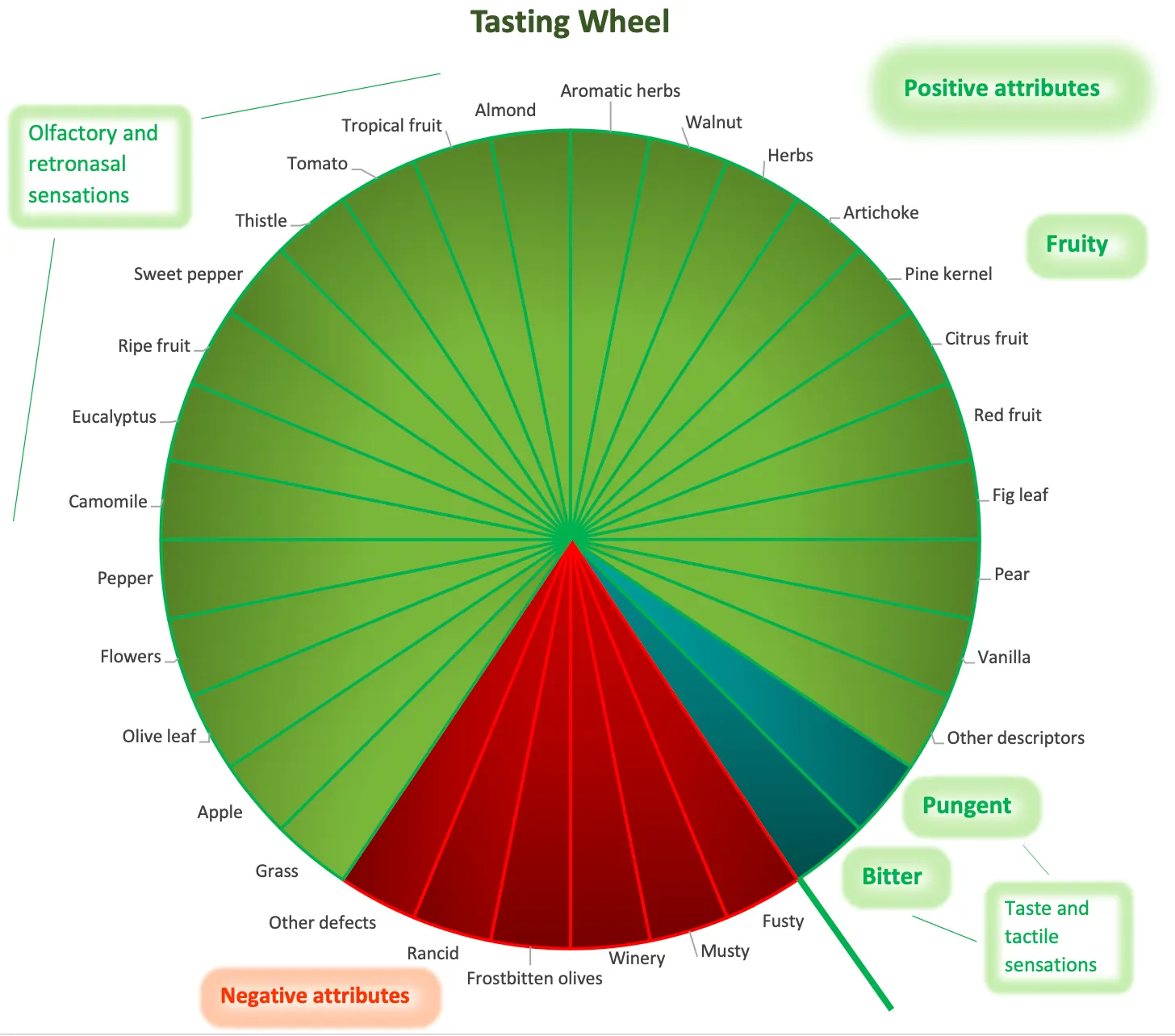November 16, 2025
Delving into the world of olive oil tasting is a fascinating sensorial experience! Learning how to taste olive oil can bring many benefits to us consumers. Understanding the difference between the various types of extra virgin olive oils helps us choose the best products to improve our dishes. Furthermore, knowing how to identify high quality extra virgin olive oils permits us to choose the best products for our health.
If you want to improve your ability to evaluate the quality of an extra virgin olive oil, you can simply practice olive oil tasting at home, training with the products that you have at hand, and by following the method used by the professional olive oil tasters.
The organoleptic assessment (sensory testing) used to classify extra virgin olive oils is regulated by current legislation that refers to a method, recognized and shared at a global level, and issued by the International Olive Oil Council.
Tools and conditions before olive oil tasting
The evaluation of olive oil is carried out in a dedicated tasting room by a panel made up of at least 8 selected and trained tasters led by a panel leader. The assessment is performed using a standardized cobalt blue glass (more rarely, garnet red or rust brown), so that the color of the oil cannot be seen and does not influence the evaluation. The professional tasters evaluate the characteristics of the samples heated to 28°C (82.4°F) and classify them according to the presence of positive attributes or defects. The tasters record these features on a specific classification form. The results are then statistically calculated by the panel leader.

Extra virgin olive oil attributes 101
A good extra virgin olive oil has the main positive attributes of:
• Fruitiness or the set of olfactory sensations, perceived directly and/or retro-nasally, indicating the presence offragrant, healthy, fresh olives, picked at the right degree of ripeness.
• Bitterness or the bitter taste that is perceived by the palate at the back of the tongue
• Pungency is the tactile stinging sensation that can be perceived throughout the oral cavity, especially in thethroat.
Fruitiness and aromas
Each olive oil has different aromas and flavors such as grass, thistle, artichoke, tomato, apple, banana, wild berries, flowers, basil, licorice, and many other components of the plant world that can be sensorially detected in a good product. Many variables affect the organoleptic expression of an extra virgin olive oil, including the variety of olives, the level of ripeness,the soil and climatic conditions, the agronomic methods and extraction techniques, and the storage. The products from a single variety can also be blended with others to obtain extra virgin olive oils with a potentially infinite number of aromas and flavors.
Bitterness and pungency
Bitterness and pungency show the presence of antioxidant, compounds such as polyphenols, which are beneficial substances for our health. Not only do they play a fundamental role in determining the organoleptic profile and the stability of the product, but also give nutraceutical properties to it. Substances such as oleuropein, among those responsible for the bitter taste, and oleocanthal, a molecule related to the pungent sensation, have recognized antioxidant and anti-inflammatory properties.
These bittering and tingling sensations should not be confused with acidity, a parameter that represents the content of free fatty acids, which cannot be perceived by human senses, and is detected only through chemical analysis.
According to the intensity of these attributes the oil can be broadly classified as:
• light
• medium
• intense
Types of negative attributes
If something goes wrong during one or more of the production phases, the oil turns out to have negative attributes, called defects.
• The most common are fusty or muddy sediment, when oil is obtained from olives which have undergone an anaerobic fermentation during storage, or when oil has been left in contact with the sediment that settles in tanks;
• Musty or humid or earthy, when the oil is obtained from fruits in which fungi and yeasts have developed or when oil is obtained from olives that have been collected with earth or mud;
• Winery, when the flavor of oil recalls wine or vinegar due to a fermentation;
• Rancid is, when oil has undergone an intense process of oxidation which bring unpleasant aromas and tastes to the product.
We hope that these undesirable traits are not present in the oils you use in your kitchen and on your tables. In order for you to figure it out and better comprehend the quality of the extra virgin olive oils you use, you can replicate the below-described tasting method, which is similar to wine tasting, following some simple instructions.

It’s time to do your olive oil tasting
Pour:
Pour a little oil into a glass. Use a simple glass, or a cup made with compostable material, that must be clean and odor-free. Now, take four simple steps, that we may call the
The 4 S’s rule:
• Swirl: Hold the glass in one hand, covering it for a while with the palm of the other so as to warm it up to enhance the volatile components and avoid their dispersion. Tilt slightly and rotate the glass to wet the inner surface as much as possible.
• Smell: Smell the sample by taking some slow and deep inhalations for no more than 30 seconds. Try to perceive pleasant or unpleasant sensations. If in this period no conclusion has been reached, one can take a break and proceed to a new attempt.
• Slurp: Take a small sip, about 3 ml of oil, and evaluate the oral sensations. In order to reach all our sensory receptors, use a technique called ‘strippaggio’ in Italian that consists in inhaling two or three times in a short but decisive way, keeping the teeth clenched so that the oil is vaporized in the oral cavity. Try to perceive and memorize sensations, fruitiness, bitterness, pungency, and other descriptors, and/or the presence of defects.
• Swallow: Swallow the oil – unless it has an unpleasant taste – and try to perceive the tactile sensations.
You can eat a thin slice of Granny Smith apple, or a morsel of plain bread, followed by water, better if sparkling, to cleanse your mouth between one sample and another.
Try this procedure with different tunisian extra virgin olive oils and compare them. The more you practice the more you will be able to identify and choose the best extra virgin olive oil to use in your kitchen and on your tables.
